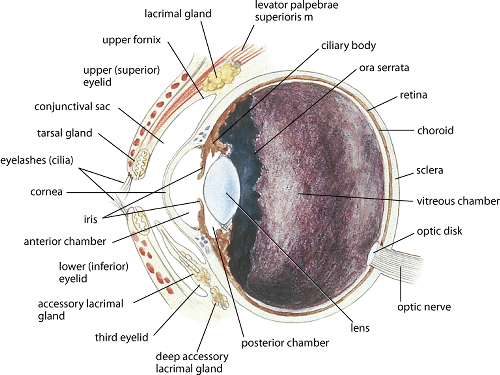Physical Examination of the Eye
- Ophthalmology
- Physical Examination of the Eye
- Eyelids
- Nasolacrimal and Lacrimal Apparatus
- Conjunctiva
- Cornea
- Anterior Uvea
- Glaucoma
- Lens
- Ocular Fundus
- Optic Nerve
- Orbit
- Prolapse of the Eye
- Ophthalmic Manifestations of Systemic Diseases
The initial examination of the eye should assess symmetry, conformation, and gross lesions; the eye should be viewed from 2–3 ft (~1 m) away, in good light, and with minimal restraint of the head. The anterior ocular segment and pupillary light reflexes are examined in detail with a strong light and under magnification in a darkened room. Baseline tests like the Schirmer tear test, fluorescein staining, and tonometry (intraocular pressure measurement) may be followed by ancillary tests such as taking corneal and conjunctival cytology and cultures, everting the eyelids for examination, and flushing the nasolacrimal system to evaluate the external parts of the eye, including the anterior segment. Diseases of the vitreous and ocular fundus are evaluated by direct and indirect ophthalmoscopy (usually performed after inducing mydriasis) and vision testing (menace reflex, obstacle course, dazzle reflex, etc).
Schirmer tear tests and cultures should be performed before topical anesthetic is instilled. Fluorescein staining and eversion of the eyelids do not require topical anesthesia, but tonometry, examination of the bulbar surface of the nictitating membrane, conjunctival and corneal cytology, gonioscopy, and lavage of the nasolacrimal system usually do. To avoid false-positives, samples for corneal and conjunctival cytology that will be analyzed by fluorescent antibody procedures should be collected before topical fluorescein staining.
Special examinations such as slit-lamp biomicroscopy, ultrasonography, fluorescein angiography, and electroretinography may require sedation or local, regional, or general anesthesia, depending on the species.
Resources In This Article
- Ophthalmology
- Physical Examination of the Eye
- Eyelids
- Nasolacrimal and Lacrimal Apparatus
- Conjunctiva
- Cornea
- Anterior Uvea
- Glaucoma
- Lens
- Ocular Fundus
- Optic Nerve
- Orbit
- Prolapse of the Eye
- Ophthalmic Manifestations of Systemic Diseases






